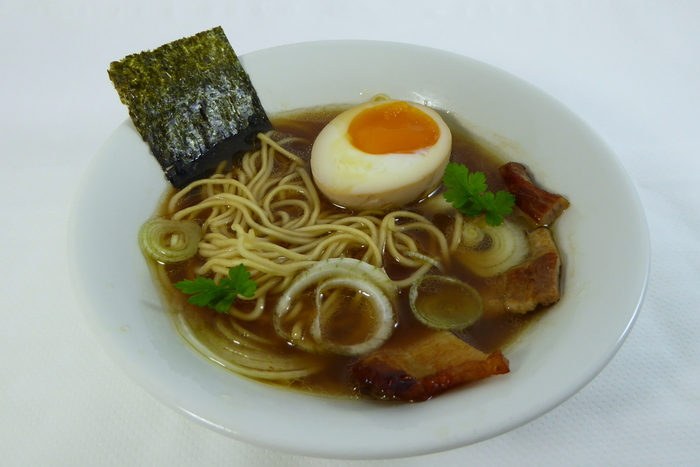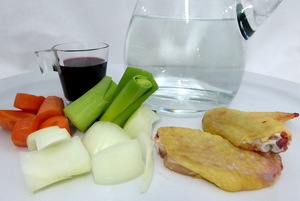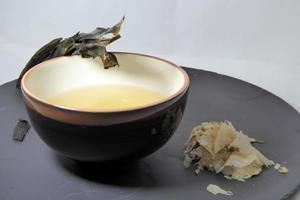Ramen soup
19 h
Seasonal period:
All year
Allergens:
Ingredients for 5 portions
Calculate portions
Dark poultry stock
1.5 l
Dashi stock
0.5 l
Chinese noodles
0.2 kg
Bean sprouts
0.15 kg
Spring onions
1.0 ud
Eggs
2.5 ud
Soya sauce
0.375 l
Mirin
0.15 l
Sake
0.15 l
Ginger
25.0 g
Pork belly
0.25 kg
Garlic, bulb
1.0 ud
Nori seaweed
2.5 g
Poultry carcasse
0.225 kg
Onion
0.075 kg
Carrots
0.075 kg
Green leek
0.375 ud
Kombu seaweed
0.015 kg
Atún seco (Katsuobushi)
0.02 kg
Water
0.5 l
Elaboration
- Make a dark poultry stock and a dashi stock. (Optional to clarify the poultry stock), use 3 parts of the poultry stock and 1 part Dashi (that will be the base of the soup.)
- Heat the olive oil in a deep pan. Gently fry the ginger and garlic in the pan. Set aside the ginger and garlic.
- Add the poultry and dashi stock to the pan and heat to 85 °C (without boiling.)
- Add sugar, salt, sake and soy sauce to the soup. Adjust the flavor and the seasoning.
- Meanwhile, boil water in a large pot. Add the noodles to the boiling water and cook them for a few minutes or according to the package instructions.
- Serve the hot soup in individual bowls.
- Strain the noodles and serve them with the hot soup.
- Garnish the soup with noodles, a square of nori seaweed on one side, the finely chopped chives and some pepper. Add the Nibuta, the bean sprouts and the Ajitsuke tamago.
For the Nibuta:
- Heat some oil in a large frying pan and brown the pork over medium heat until it is sealed on all sides. In a pot place the sake, soy sauce and sugar, bring to the boil over a high heat. Turn off the heat and allow to cool.
- In a vacuum bag suitable for cooking, introduce the pork, the soy, sake and sugar reduction, the ginger and the chives. Pack under maximum vacuum (60 seconds) and cook in a mixed oven steam function 100 % humidity at 70 ºC for 18 hours. Lower the temperature to less than 8 ºC in under 2 hours using the blast chiller or an iced bain-marie.
- When ready to consume, Slice 5 mm thin fillets in the slicing machine and cut into bite-size squares (approximately 5 x 5 centimeters).
For the Ajitsuke Tamago:
- Boil the eggs for 5 minutes over a low heat. Once cooked, dip in iced water to stop them boiling. Peel carefully so as not to break the eggs. In a saucepan with a little water, mix the soy sauce, sake, mirin, sugar, garlic and ginger and boil for about 10 minutes. Turn off the heat and temper. Introduce the eggs in the sauce for at least 4 hours to marinate in the fridge.
- Half an egg is used per serving.
Nutritional information (1 portion)
Energy
571.1
kcal
Carbohydrates
43.71
g
Proteins
25.7
g
Lipids
26.04
g
Sugars
4.66
g
Salt (Sodium)
13138.25
mg
Folic acid
92.37
ug
Vitamin C
11.37
g
Vitamin A
264.78
ug
Zinc
2.3
mg
Iron
5.18
mg
Calcium
135.53
mg
Cholesterol
143.52
mg
Polyunsaturated fatty acids
4.32
g
Monounsaturated fatty acids
10.22
g
Saturates
8.11
g
Fiber
5.01
g
The data is merely a guide and should not be used for medical purposes. Those responsible for the web disclaims any responsibility.
Needed recipes
-
Type of dish
- Beers
- Cocktails
- Breakfasts and brunch
- Burguers
- Juices, milkshakes and beverages
- Shellfish
- Bread and pastries
- Pizzas, patty
- Dessert
- Pasta
- Sándwich
- Pastries
- Finger foods
- Ice creams and sorbets
- Legumes
- Salads
- Eggs
- Patty
- liqueur
- Harvard plate
- Main course
- Meats
- Fish
- Birds
- Vegetables
- Soups and creams
- Rices
- Coffee, chocolate and infusion
- Cheeses
- Appetizers and canapes
- Temperature
- Cuisine type
- Additional culinary preparation
- Conservation technique
- Seasonal recipes
-
- Aromatic herbs
- Beverages
- Big game hunt
- Bread and pastries
- Canned goods and pickles
- Cereals
- Condiments, spices and additives
- Cooked, salted, preserved and cold meats
- Dried fruits and nuts
- Dry pulses
- Edible oils and vinegars
- Eggs and derivatives
- Feathered game hunt
- Fish cuts
- Fishes
- Insects
- Kitchen and bakery tecniques
- Kitchen and bakery utensils
- Meat cuts
- Meats
- Milk, cream and derivatives
- Mushrooms
- Offal
- Pasta, rice, flour and derivatives
- Poultry
- Seafood
- Service techniques
- Service utensils
- Vegetables cuts
- Vegetables, fruits, tubers and seaweed



